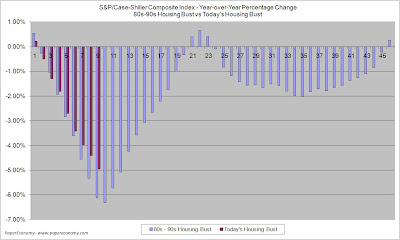
Today’s release of the S&P/Case-Shiller home price indices for August continued to show significant weakness for the nation’s housing markets with 15 of the 20 metro areas tracked reporting year-over-year declines and now virtually ALL (except Charlotte NC which changed 0.0%) metro areas showing declines from their respective peaks.
Topping the list of peak decliners are Detroit at -12.18%, Tampa at -10.57%, San Diego at -9.43%, Miami as -9.11%, Washington DC at -8.38%, Phoenix at -8.16% and Las Vegas at -7.65%.
Additionally, both of the broad composite indices showed accelerating declines slumping -5.28% for the 10 city national index and -4.53% for the 20 city national index on a peak comparison basis.
Also, it’s important to note that Boston, having been cited as a possible example of price declines abating, has now again resumed its decline dropping -3.62% on a year-over-year basis and a solid -6.32% from the peak set back in September 2005.
As I had noted in prior posts, Boston has a strong degree of seasonality to its price movements and with both the seasonal drop in sales and the recent stunning new decline to sales as a result of the disappearance of Jumbo and Alt-A loans, Boston will likely continue on yet another significant leg down in prices.
To better visualize the results use the PaperEconomy S&P/Case-Shiller/Futures Charting Tool and be sure to read the Tutorial in order to best understand how best to utilize the tool.
Additionally, in order to add some historical context to the perspective, I updated my “then and now” CSI charts that compare our current circumstances to the data seen during 90s housing decline.
To create the following annual charts I simply aligned the CSI data from the last month of positive year-over-year gains for both the current decline and the 90s housing bust and plotted the data with side-by-side columns (click for larger version).
 What’s most interesting about this particular comparison is that it highlights how young the current housing decline is, having only posted four consecutive year-over-year (YOY) monthly declines to home prices.
What’s most interesting about this particular comparison is that it highlights how young the current housing decline is, having only posted four consecutive year-over-year (YOY) monthly declines to home prices.Looking at the actual index values normalized and compared from the respective peaks, you can see that we are only ten months into a decline that, last cycle, lasted for roughly fifty four months during the last cycle (click the following chart for larger version).
 The “peak” chart compares the percentage change, comparing monthly CSI values to the peak value seen just prior to the first declining month all the way through the downturn and the full recovery of home prices.
The “peak” chart compares the percentage change, comparing monthly CSI values to the peak value seen just prior to the first declining month all the way through the downturn and the full recovery of home prices. In this way, this chart captures ALL months of the downturn from the peak to trough to peak again.
In this way, this chart captures ALL months of the downturn from the peak to trough to peak again.As you can see the last downturn lasted 97 months (over 8 years) peak to peak including roughly 43 months of annual price declines during the heart of the downturn.
Notice that peak declines have been FAR more significant to date and, keeping in mind that our current run-up was many times more magnificent than the 80s-90s run-up, it is not inconceivable that current decline will run deeper and last longer.